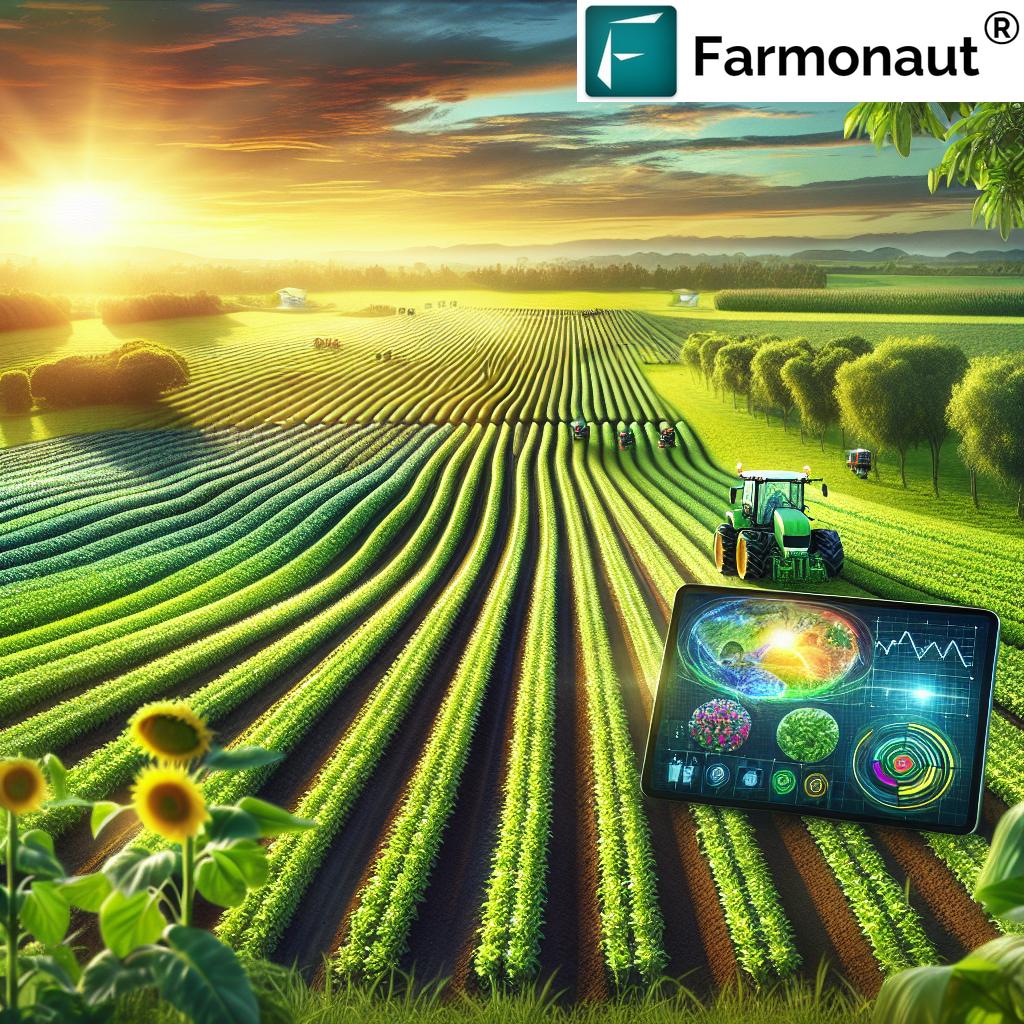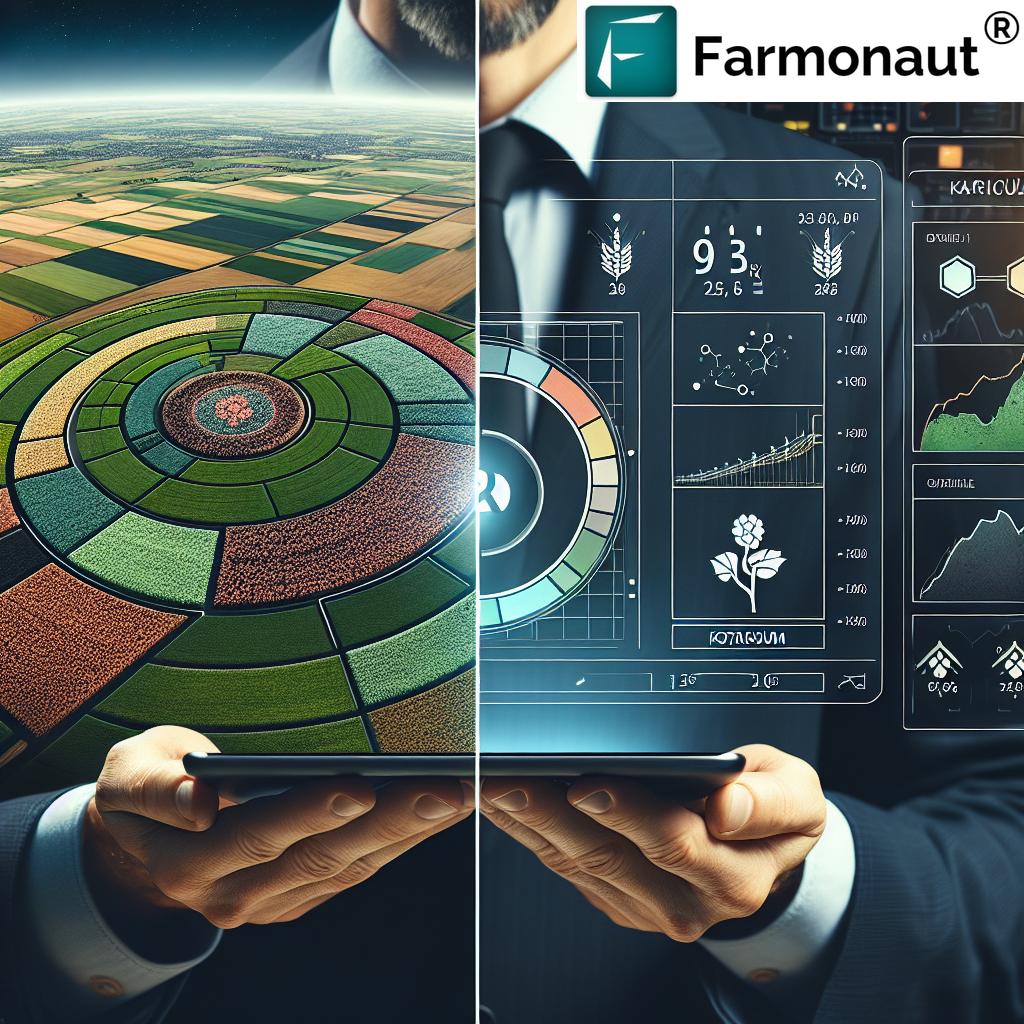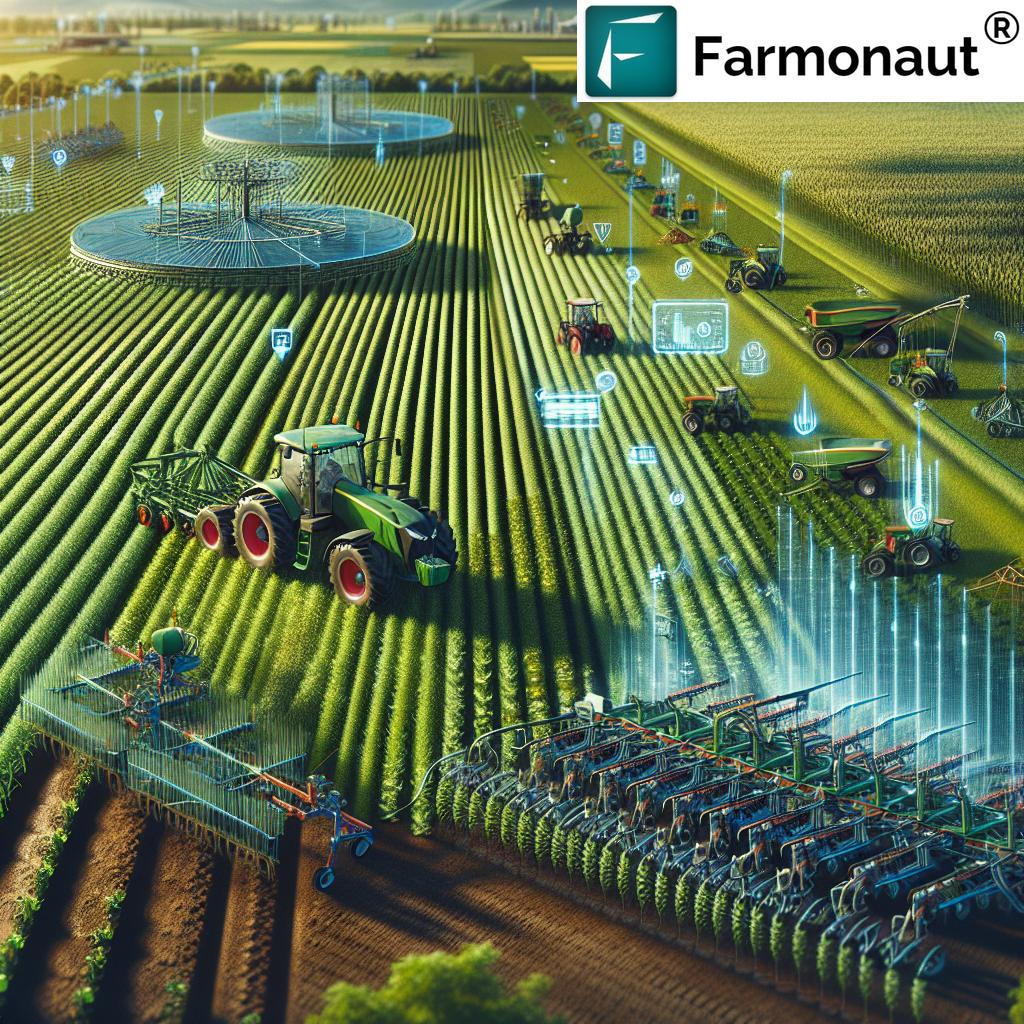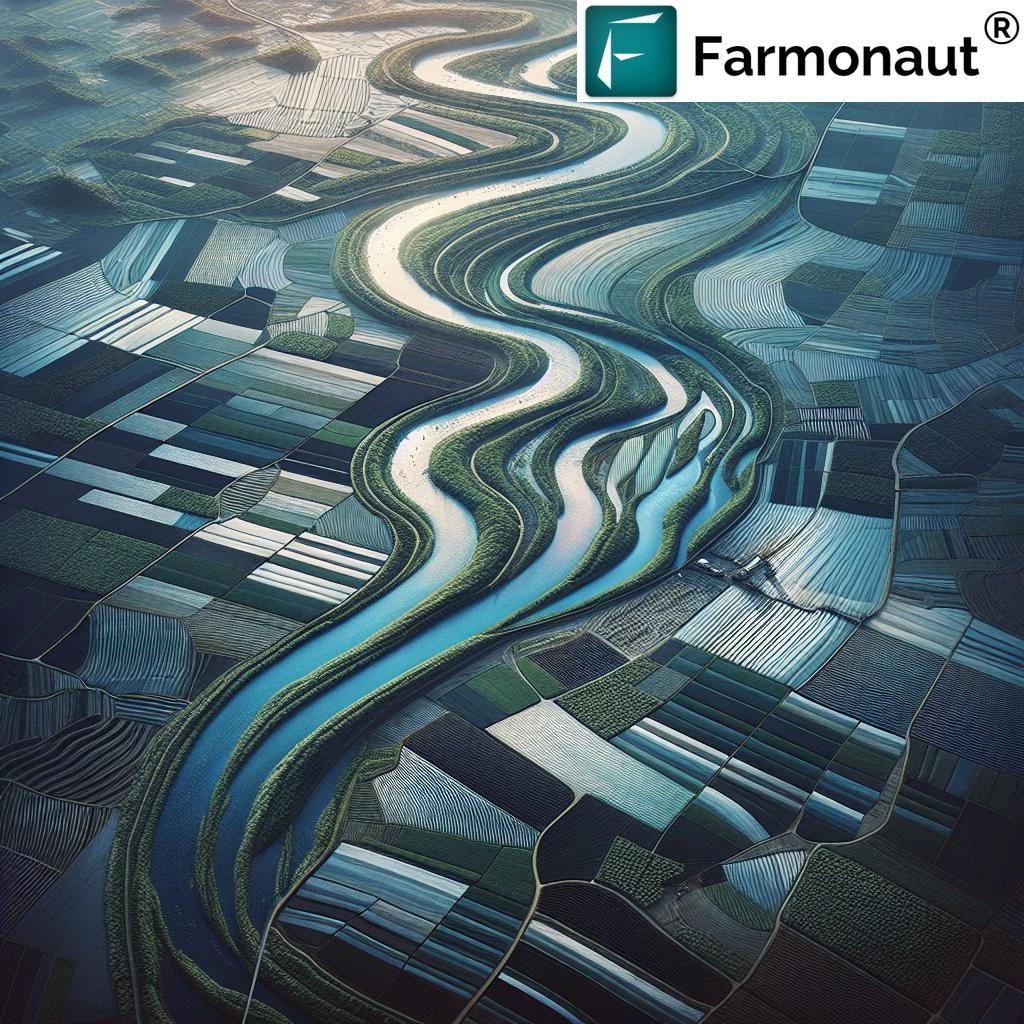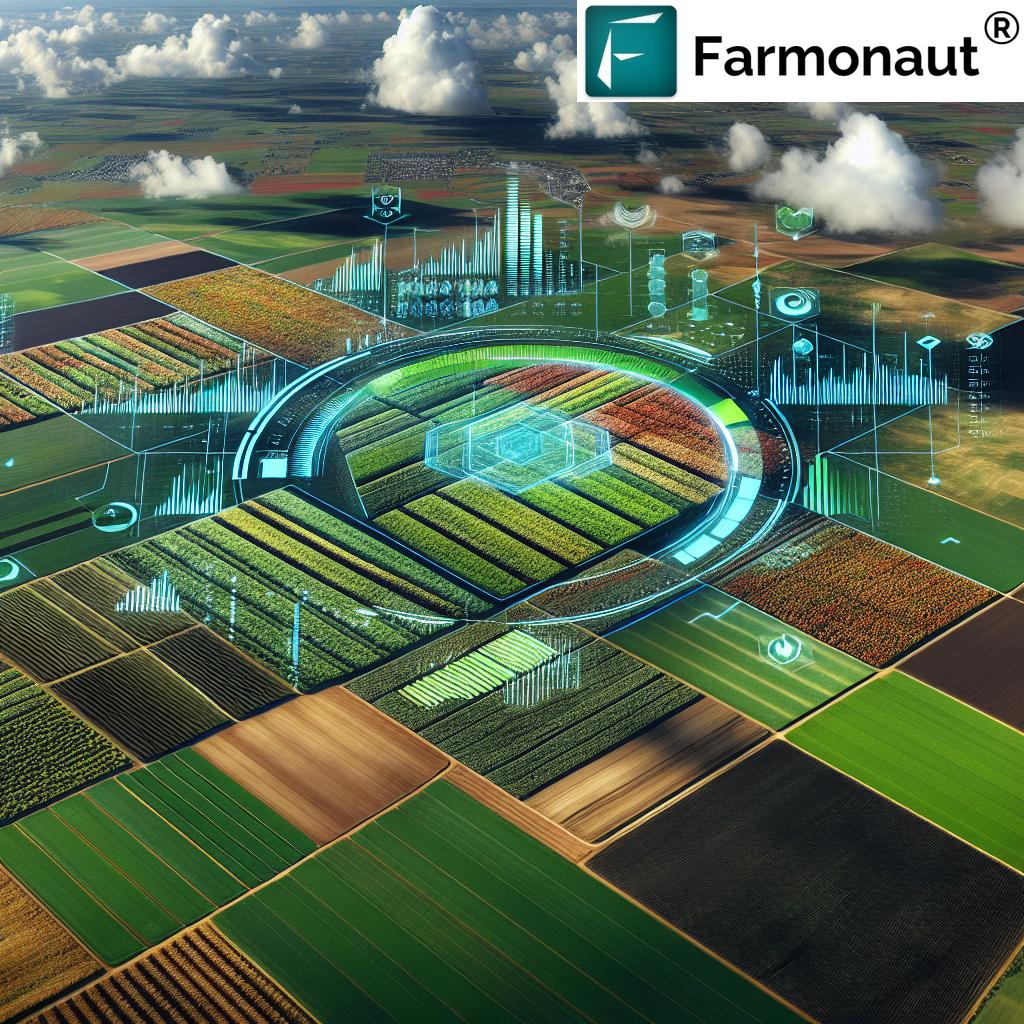Smart Farming Technologies 2025: Benefits & Innovations
- Introduction: The Rise of Smart Farming Technologies
- Farm Tech Trivia #1
- Why Smart Farming Technologies Matter in 2025
- Key Technologies in Smart Farming 2025
- Comparison Table of Smart Farming Technologies in 2025
- Benefits of Smart Farming Technologies 2025
- Farm Tech Trivia #2
- Challenges & Considerations
- Farmonaut: Innovative Solutions in Precision Farming
- The Future of Smart Farming
- Frequently Asked Questions
Introduction: The Rise of Smart Farming Technologies
The landscape of agriculture is changing rapidly as we move into 2025. Smart farming technologies 2025 have become essential to meet the growing demands for food, sustainability, and resilience in a world faced with climate change, labor shortages, and limited natural resources. Known also as precision agriculture, technology smart farming integrates advanced tools like IoT, artificial intelligence (AI), robotics, drones, and innovative resource management systems to optimize every aspect of crop production and farm management.
In this comprehensive guide, we explore the key innovations, benefits, and future outlook for smart farming technologies, providing farmers, agribusinesses, and agricultural enthusiasts actionable insights into the systems shaping the new era of sustainable and efficient farming.
Why Smart Farming Technologies Matter in 2025
The world’s population is on track to reach 8.5 billion by 2030, putting increased pressure on food production systems. At the same time, extremes in climate, water scarcity, rising input costs, and diminishing arable land are making conventional farming practices harder to sustain. To thrive, farmers and agribusinesses must adopt technology smart farming solutions—tools that enhance efficiency, boost yields, minimize environmental impact, and support sustainable resource management.
Not just a trend, smart farming technologies are a necessity. Through real-time data, precision automation, and optimal resource deployment, these advances offer both immediate and long-term solutions to global agricultural challenges.
Key Technologies in Smart Farming 2025
At the heart of smart farming technologies 2025 are systems that combine advanced IoT devices, data analytics, robotics, and automation with proven farming knowledge. Below, we explore the key smart farming technologien driving innovation, sustainability, and profitability.
1. Internet of Things (IoT) in Farming
- IoT sensors, connected drones, and smart cameras collect real-time data on soil moisture, temperature, crop health, weather, pH, nutrient levels, and more.
- This data is transmitted to central management systems for further analysis, allowing farmers to monitor crops continuously and react quickly to emerging issues.
- Source: International Scholars Journals
IoT Use Cases:
- Optimized irrigation to reduce water waste
- Environmental monitoring for disease and pest detection
- Predictive analytics for yield improvement
2. Artificial Intelligence and Machine Learning
- AI algorithms use vast amounts of data from IoT devices to identify patterns, predict crop growth, detect diseases and pests, and recommend optimal farming practices.
- Systems built on machine learning continuously refine their accuracy and predictive power, becoming invaluable for precision farming.
- Source: fnb.tech
3. Robotics, Automation, and Drones
- Automated machinery—from self-driving tractors to robotic harvesters, unmanned aerial vehicles (drones), and field robots—perform key tasks like planting, irrigation, fertilization, and harvesting with minimal human intervention, improving efficiency and reducing labor costs.
- Drones provide rapid crop scouting, spray applications, and multispectral imaging for monitoring crop health.
- Source: fnb.tech
4. Smart Irrigation Systems
- IoT-enabled irrigation and automation tools deliver water precisely—where and when crops need it most—minimizing waste and maximizing growth.
- Soil moisture sensors and weather stations help create dynamic irrigation schedules that adjust automatically to changing conditions.
- Source: psa.inc
5. Precision Fertilization and Nutrient Management
- Data-driven soil analysis combined with real-time monitoring ensures fertilizers are applied only where needed and at optimal rates.
- This minimizes waste, reduces environmental impact, and improves plant health.
- Source: psa.inc
6. Agrivoltaics and Renewable Energy Integration
- Agrivoltaics (agricultural solar) combines solar panel installations with crop cultivation, providing shade, reduced water use, and renewable energy production.
- Farms directly benefit from lower energy costs and extra income streams, while crops gain from better growing microclimates.
- Source: Wikipedia
Comparison Table of Smart Farming Technologies in 2025
| Technology | Key Functions | Est. Adoption Rate (%) | Est. Yield Improvement (%) | Resource Savings (%) | Sustainability Rating (1-5) |
|---|---|---|---|---|---|
| IoT Sensors & Devices | Soil & crop monitoring, data collection | 68% | 18% | 20% | 5 |
| AI-based Analytics | Pattern recognition, forecasting, decision support | 60% | 22% | 17% | 5 |
| Drones | Aerial crop health mapping, spraying, precision scouting | 35% | 15% | 12% | 4 |
| Automated Tractors & Robotics | Planting, harvesting, tasks automation | 27% | 14% | 10% | 4 |
| Smart Irrigation Systems | Precision water delivery, automation | 47% | 13% | 32% | 5 |
Benefits of Smart Farming Technologies 2025
Smart farming technologies benefits are broad, catering to productivity, efficiency, sustainability, and improved decision-making. Let’s delve into the major gains for farmers worldwide.
Increased Productivity & Crop Yields
-
Precision farming methods and automation mean more crops harvested per hectare, improving both yield and produce quality.
Real-time environmental data enables timely intervention for growth, while predictive analytics optimize planting and harvesting times. -
Source: Bizblog
Reduced Costs
- Automation and targeted resource use (like those enabled by large-scale farm management platforms) lower costs for labor, fuel, chemicals, and water.
- Remote monitoring allows for greater operational efficiency
Enhanced Sustainability
- Minimized use of water and chemicals through IoT-enabled irrigation and precision fertilization supports environmental conservation and sustainable agriculture practices.
- Carbon footprint tracking (see Farmonaut’s dedicated carbon footprint monitoring solution) helps farms become climate-resilient.
Improved Decision Making & Monitoring
- Real-time farm data empowers farmers to make informed, timely decisions on planting, irrigation, and intervention, maximizing resource efficiency.
- Centralized dashboards and AI suggestions (like those in Farmonaut’s Jeevn AI) simplify complex decision-making.
Better Crop Health & Disease Management
- Continuous monitoring enables early diagnosis of diseases, pests, or nutrient shortages—ensuring rapid intervention.
- Advanced traceability (see Farmonaut’s blockchain traceability solution for food and textile sectors) builds consumer trust in the food supply chain.
Labor Optimization and Automation
- Robotics, self-driving tractors, and automated irrigation/watering systems reduce manual labor needs.
- Remote tools and APIs, like those offered by Farmonaut (API link, API Developer Docs), let management happen on mobile/web—reducing time and operational stress for farm owners.
Challenges & Considerations in Smart Farming Technologies 2025
1. High Initial Investment
Smart farming technologies require upfront investment in equipment, software, and training, which may be challenging for smallholder farmers or those without access to agricultural financing. However, new solutions like satellite-based farm verification (Farmonaut’s crop loan and insurance support) are helping to lower these barriers for more producers.
2. Data Management and Security
The vast amounts of data generated by sensors and IoT devices need effective systems for storage, analysis, and interpretation. Data privacy and security are major concerns; robust data protocols must safeguard sensitive agricultural and personal information from misuse.
3. Need for Technical Expertise
The adoption of smart farming technologien means farmers may need additional training to leverage new technologies. Investments in digital literacy, troubleshooting, and infrastructure upgrades are critical for successful deployment.
4. Connectivity and Infrastructure Gaps
Many farming regions, especially in developing countries, may lack reliable internet connections or electrical infrastructure. Technologies and platforms must address these gaps to prevent digital exclusion.
5. Integration with Traditional Practices
Integrating advanced digital tools with longstanding agricultural practices requires careful change management and cultural adaptation.
Farmonaut: Innovative Solutions in Precision Farming
At Farmonaut, we are dedicated to making precision agriculture accessible and affordable for farmers globally. We deliver satellite-based crop health monitoring, AI-driven advisory systems, and resource management tools through a user-friendly Android, iOS, web app, and API suite.
- Satellite-Based Crop Health Monitoring: Our multispectral satellite imagery delivers real-time analytics on vegetation, soil moisture patterns, and crop health. This invaluable data enables farmers to implement timely interventions, optimize irrigation, and reduce wasteful practices.
- AI Advisory (Jeevn AI): Jeevn AI analyzes your satellite and weather data to offer tailored farming recommendations, boost efficiency, and improve yields.
- Blockchain Traceability: Our system brings full transparency and secure tracing to agricultural supply chains. (Learn more about product traceability)
- Resource & Fleet Management: Remotely manage your entire fleet to maximize operational efficiency. (See our fleet management tools)
- Carbon Footprinting: Track and manage emission profiles to enhance your farm’s climate resilience. (Learn about carbon footprint monitoring)
- Crop Loan & Insurance: Use our platform for satellite-based crop verification, expediate loan/insurance paperwork, and boost credit access. (Explore lending and insurance solutions)
- Large-Scale Farm Management: Centralize field operations, improve resource allocation, and gain analytical insights. (Try large-scale management tools)
Our mission is to empower farmers—regardless of location or scale—with data and digital tools that improve yields, efficiency, and sustainability, while driving down costs. Unlike traditional platforms requiring expensive on-field hardware, we leverage global satellite networks—maximizing reach, minimizing costs, and supporting both smallholder and commercial agriculture.
The Future of Smart Farming Technologies
Looking forward, smart farming technologies 2025 will continue to evolve, providing even more sophisticated data analytics, automation, renewable energy integration, and user-friendly tools for farmers at all scales.
Emerging Trends:
- Wider Adoption: As costs fall and benefits become clear, more smallholder farmers will adopt data-driven strategies.
- Expanded AI Capabilities: AI tools will continue to improve, supporting risk assessment, climate adaptation, and yield predictions.
- Greater Connectivity: Improved rural networks and mobile platforms allow even remote users access to decision-support tools.
- Supply Chain Transparency: Blockchain (see our traceability system) will be critical for food safety and compliance in local and global markets.
- Focus on Sustainability: Sustainability targets will drive investments in carbon tracking, water-saving irrigation, and renewable energy, including agrivoltaics.
The next decade will see smart farming technologien destined to become the global standard—a necessity rather than an option—for all farms striving to improve productivity, profitability, and resilience in a rapidly changing world.
Frequently Asked Questions about Smart Farming Technologies 2025
What is smart farming and how does it work?
Smart farming (also known as precision agriculture) integrates advanced digital tools—such as IoT sensors, AI, and automation systems—into every stage of farm management. These technologies collect and analyze data on crops, soil, and environmental conditions to help farmers make better decisions, optimize resources, and increase yields, all while minimizing labor and environmental impact.
What are the main technologies in smart farming 2025?
The top technologies in farming for 2025 include IoT devices and sensors, artificial intelligence and machine learning analytics, robotics and automation, drones, smart irrigation, precision fertilization, and renewable energy integration such as agrivoltaics.
How do smart farming technologies benefit smallholder farmers?
While initially expensive, many platforms (like Farmonaut) make precision agriculture affordable and scalable with satellite-based insights that require no expensive hardware. Smallholder farmers gain valuable insights into crop health, soil moisture, and input application—boosting yields, reducing waste, and making farm management easier and more informed.
Are smart farming technologies secure and private?
Yes—leading platforms implement strict data security and privacy protocols. For example, Farmonaut’s blockchain-based systems make supply chains transparent and secure, ensuring that only authorized parties can access sensitive farm data.
Will smart farming technologies replace traditional farming jobs?
They won’t eliminate agriculture jobs; instead, they shift the nature of work towards digital skills and data-driven management. Automation reduces physically demanding labor while creating roles for digital monitoring, decision-support, and system maintenance.
How can I start using smart farming technologies now?
You can start with accessible, cloud-based tools like Farmonaut’s crop health monitoring and AI advisory platform (available on web, Android, and iOS). For technical integrations, our API and developer resources offer easy onboarding.
Conclusion
Smart farming technologies 2025 are revolutionizing agriculture by integrating powerful tools such as IoT, AI, automation, drones, and blockchain into traditional systems. These innovations yield substantial benefits—higher productivity, enhanced sustainability, reduced resource costs, and data-driven decision making. While challenges in cost, training, data management, and infrastructure remain, platforms like Farmonaut are democratizing the sector with affordable, real-time, and scalable solutions, helping both small and large farms thrive.
As we approach 2025 and beyond, the future of smart farming lies in even greater connectivity, automation, and commitment to environmental stewardship.




